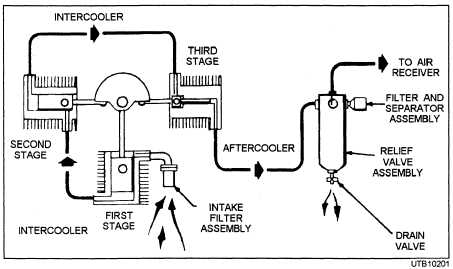much the same as the check valves operate in reciprocating pumps. The suction stroke occurs as the piston moves downward to create a partial vacuum and causes the intake valve to open. Air, at normal atmospheric pressure, is then drawn into the cylinder, as the piston continues downward. When the piston moves on the upward stroke, the intake valve closes. The trapped air is compressed as the piston continues upward. As the piston reaches the top of its compression' stroke, the air pressure developed over- comes the resistance of the spring-loaded discharge valve.
The discharge valve opens momentarily and the compressed air charge then passes into the discharge line. When higher pressure is desired, more cylinders or stages may be provided (fig. 6-36). The discharge of the first stage is led to the intake of the second stage, and so on. The principle here is almost the same as that in the multistage impeller arrangements used to increase the discharge pressure on centrifugal pumps. Figure 6-37 shows a more detailed view of a two-stage reciprocating air compressor. You can see that the second-stage cylinder is noticeably smaller than the first. If there were more cylinders, each would be smaller. This is the compression process, whereby the volume of the air charge is continually reduced as it passes from one stage to the next; and, at the same time, the pressure becomes greater. Figure 6-38 shows an alternate type of low-pressure air compressor.
COMPRESSOR COMPONENTS
The pistons are either TRUNK PISTONS or DIFFERENTIAL PISTONS. Trunk pistons, as shown in view A, figure 6-39, are driven directly by the connecting rods. Since the upper end of a connecting rod is fitted directly to the piston (also referred to as wrist or trunk) pin, the piston tends to develop a side pressure against the cylinder walls. To distribute the side pressure over a wide area of the cylinder walls or liners, use pistons with long skirts. This type of piston minimizes cylinder wall wear. Differential pistons, as shown in view B, figure 6-39, are modified trunk pistons with two or more different diameters. These pistons are fitted into special cylinders arranged so more than one stage of compression is achieved by one piston. The compression for one stage takes place over the piston crown; compression for the other stage(s) takes place in the annular space between the large and small diameters of the piston.
Drain cocks are provided at the bottom of the compressor suction control and the engine speed control. These cocks should be left open when the unit is standing idle, particularly in freezing weather. They must be closed before starting the engine. Check the oil level in the oil storage tanks as indicated by the gauge. If necessary, add oil according to the oil specifications given in the manufacturer's lubrication manual. Drain any condensate that has accumulated in the bottom of the oil storage tanks. A drain cock is provided on the piping at the bottom of the left-hand oil storage tank. Open this cock and keep it open as long as water is draining out. Close the cock quickly when oil starts draining.
LUBRICATION SYSTEM
Except for oil-free (nonlubricated) compressors, high-pressure air compressor cylinders are generally lubricated by an adjustable force-feed lubricator

Figure 6-36. - Air compressor assembly
Continue Reading